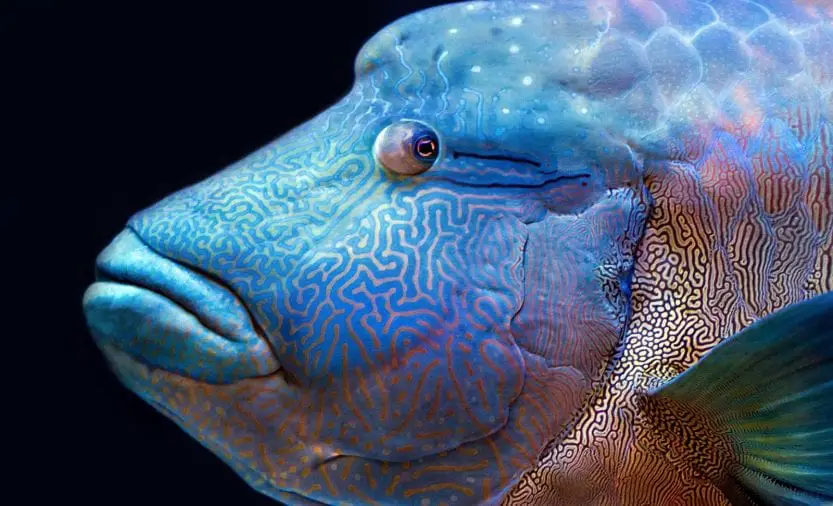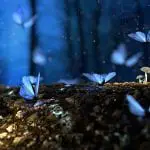Scientific name: Cheilinus undulates
Popular names: Napoleon fish, Napoleon wrasse, Maori wrasse, Blue-tooth groper
The humphead wrasse can be seen in the steep coral reefs of the tropical oceans of almost 50 countries. Its natural habitat are the Indo-Pacific Oceans. This area spreads from the Red Sea and the East African coast to the central Pacific. It also covers the waters from South Japan to New Caledonia.
The humphead wrasses are diurnal animals, active during the day. In daytime, divers find them roaming around the outer reef slopes. Humphead wrasses can be found up to a depth of 100 m. At night, they hide in reef caves and other shelters, such as coral crevices and ledges. The young ones usually stay in shallow waters and sea grass beds. The adult fish are seen at the outer coral edges. In open waters, they usually travel alone. On an average, no more than 10 humphead wrasses can be found in a 100 m × 100 m area. Occasionally, divers come across a pair of a male and female fish. During spawning, they may come in groups of hundreds.
Fact #1: Humphead wrasse has a remarkable appearance
The fish is famous for its protruding bump on the forehead, peculiar broad lips, strong teeth, and unique ‘eyelashes’ (black lines behind the eyes). The humphead wrasse is an incredibly large fish. In fact, it is one of the largest fish — males can be up to two meters long and can weigh as much as 180 kg. Females are, on average, one meter long.
The scales of this colorful fish are predominantly blue and green. The fish displays a remarkable ‘diamond’ pattern on its body, in hues of yellow and sometimes even purple. The males and the females differ in color. The males typically display blue hues, ranging from dull blue to blue-green to electric blue. The females have red, orange and white scales.
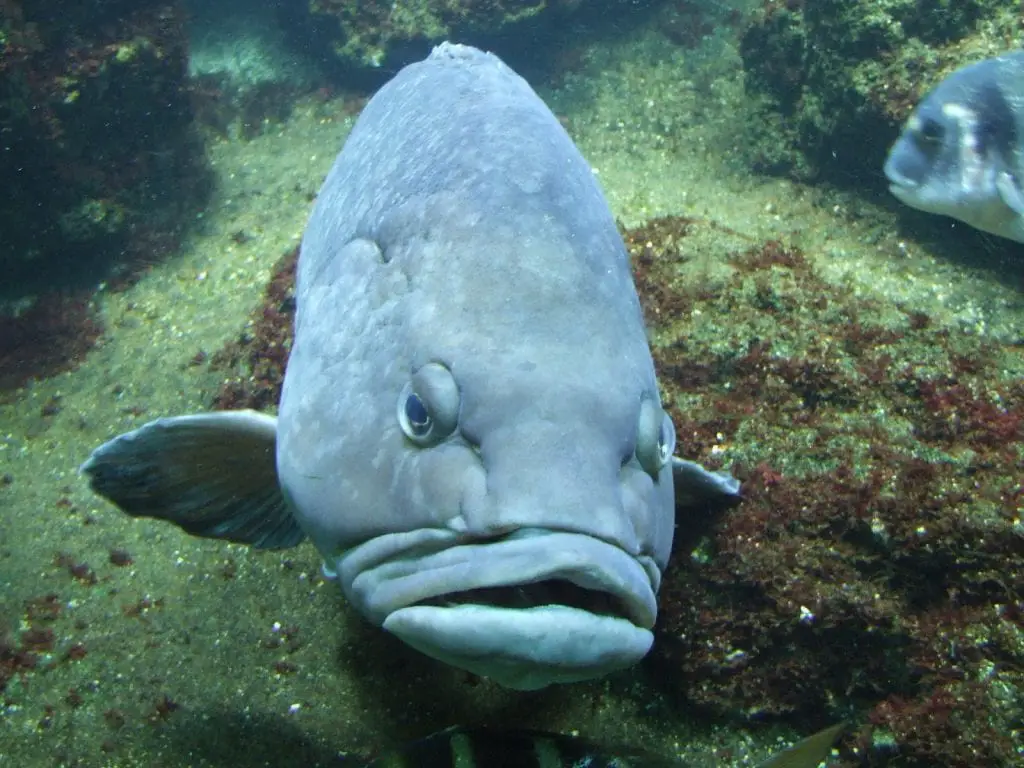
Fact #2: Only the male humphead wrasses have a hump
The hump is a sexual dimorphic trait — the hallmark hump is not found in female fish. Marine biologists believe that the size and the shape of the hump signals the genetic qualities of the male. The function of the hump is compared to that of the antlers, horns and tusks, with one exception — they are never used for fight. The older the fish, the more prominent its hump. In addition, as the male fish ages, its hump assumes a brilliant blue color.
Fact #3: Humphead wrasse has a long lifespan
This fish can reach an age of over 30 years (it has been reported to live up to 50 years). The females typically outlive their male counterparts.
Fact #4: Humphead wrasse is a hermaphrodite fish
The humphead wrasse is a protogynous hermaphrodite. A few years after they reach sexual maturity (when they are 4-6 years old), some females transition into males. The reason for this phenomenon is not yet established. Scientists hypothesize that it is a response to situations when a dominant male fish dies. It is usually the largest female that turns into a male. The process is irreversible, and the fish cannot change its sex twice. To distinguish between fish born male and a fish transformed into a male, scientists use the terms ‘initial phase males’ and ‘terminal phase males’.
Fact #5: The eggs of humphead wrasse are very small
In spite of being a mammoth fish, the humpheads produce minute eggs with a diameter of less than 0.5 mm. The female releases the eggs into the water and the male fertilizes them.
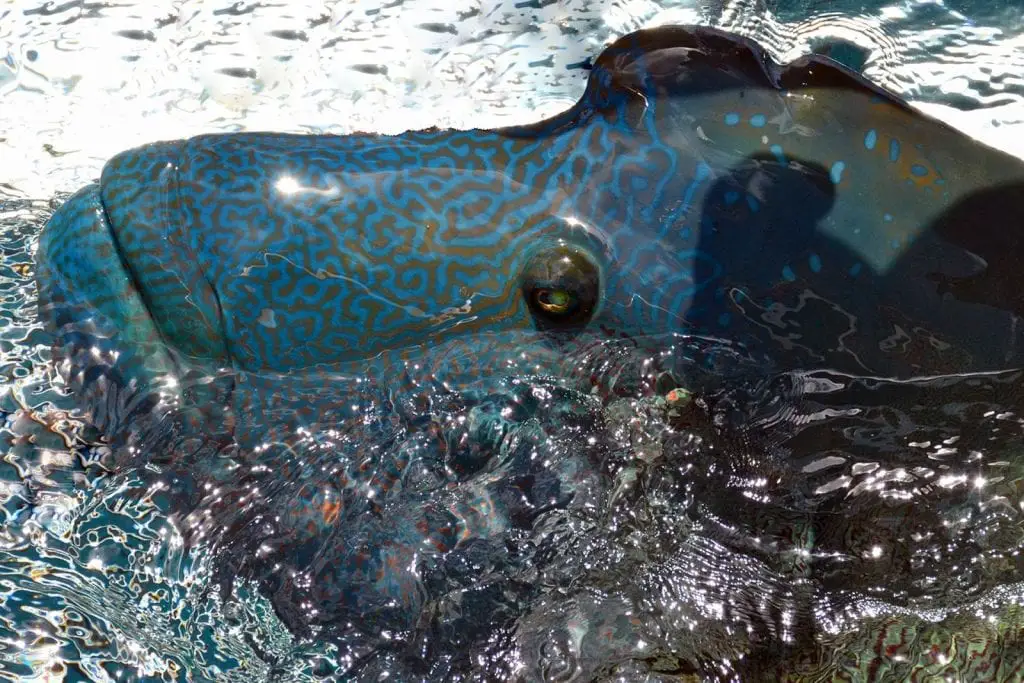
Fact #6: Humphead wrasse is a predator fish immune to toxins
The humphead wrasses are predators. They feed on other small reef fish, mollusks, sea urchins, crabs and shrimp. When they catch large prey, they either bash it against nearby rocks and consume it in pieces, or they swallow it whole. Interestingly, humphead wrasses can also eat some poisonous species, such as starfish and boxfish.
Fact #7: Humphead wrasse has two pairs of teeth
Humpheads have exceptionally strong teeth fused into a ‘beak’. They also have a second pair of teeth, known as pharyngeal teeth, located inside the throat. These tough teeth help them to feed easily on hard-shelled species.
Fact #8: Humphead wrasse protects the coral reefs
The crow-of-thorns starfish, part of the humpheads’ diet, feed on the coral and irreparably damage the already vulnerable coral reefs. By feeding on this starfish, the humphead wrasses control the population of this coral predator. This giant blue fish has been given the status of an ‘umbrella species’ — a species that provides an important eco-service. Namely, 25 percent of the world’s coral reefs are damaged beyond repair, and a large part of the remaining ones is under serious threat.
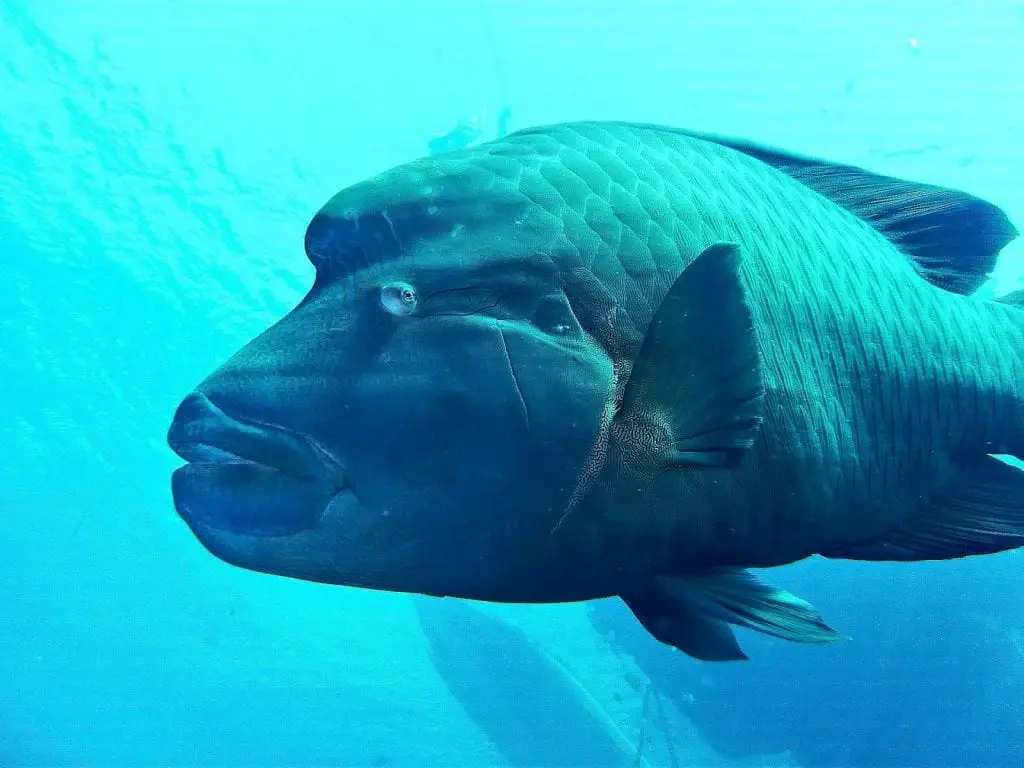
Fact #9: ‘Wally’ the Wrasse is the most famous humphead wrasse fish
One particular humphead wrasse fish, named Wally, has gained a status of a ‘celebrity fish’. Born a female, Wally’s name used to be Sarah. When Sarah was nine years old, she transitioned to a male fish (since humphead wrasses are hermaphrodites). The fish has been known as Wally ever since. Willy lived in the waters of the Great Barrier Reef in Australia. People have dedicated a Facebook page and developed a book series to Willy.
Fact #10: Some nations consider humphead wrasse a delicacy
The magnificent blue fish is considered an exotic delicacy, especially in Hong Kong. Seafood connoisseurs at high-end restaurants in China, Malaysia and Singapore are ready to pay a lot for this luxury food – the price reaches up to a several hundred US dollars per kilogram.
Fact #11: Humphead wrasse is an endangered species
Today, the global population of humphead wrasse is half of what it used to be three decades ago. This is due to overfishing practices and a significant habitat loss (damaged and endangered coral reefs)
In 2004, the International Union for Conservation of Nature (IUCN) placed this fish on the Red List of endangered species. As a result, the international wildlife trade regulations became more restrictive, especially with respect to the marine aquarium trade. Australia has banned the removal of humpheads from their natural habitat for any purpose except for education and public display.
The ‘Coral Triangle’, located between the Philippines, Indonesia and Papula New Guinea, is threatened by overfishing. While many countries have now banned the humphead wrasse trade, Indonesia continues to export up to 2,000 humpheads annually. This is worrisome, since the waters of Indonesia make up to a fifth of the global territory where humpheads are found. To make things worse, Indonesia has also developed a large humphead wrasse ranch business. The wild fish are caught young, and then raised in captivity. When they reach maturity, they are legally sold to markets and restaurants (an estimated 40,000 humpheads every year).

